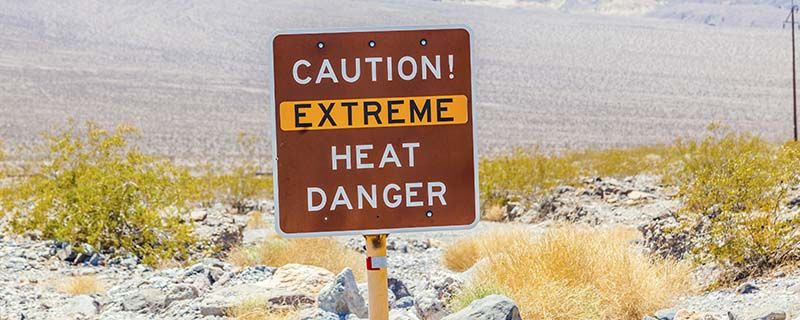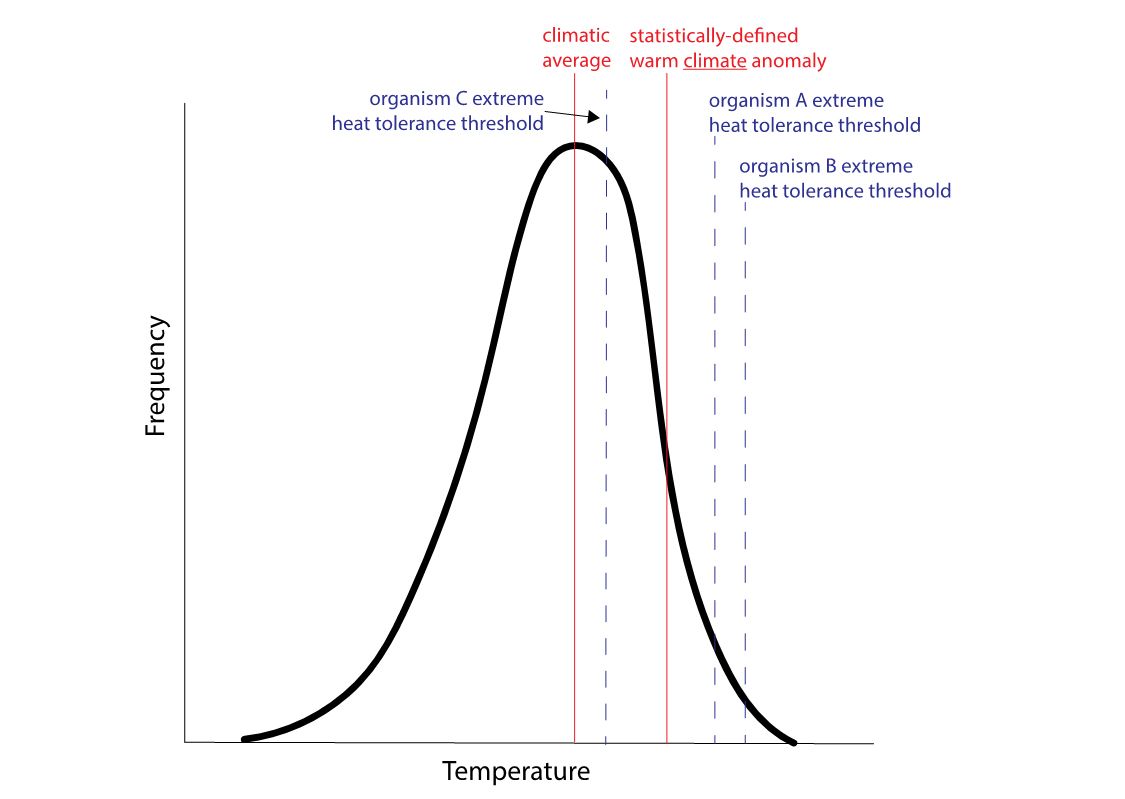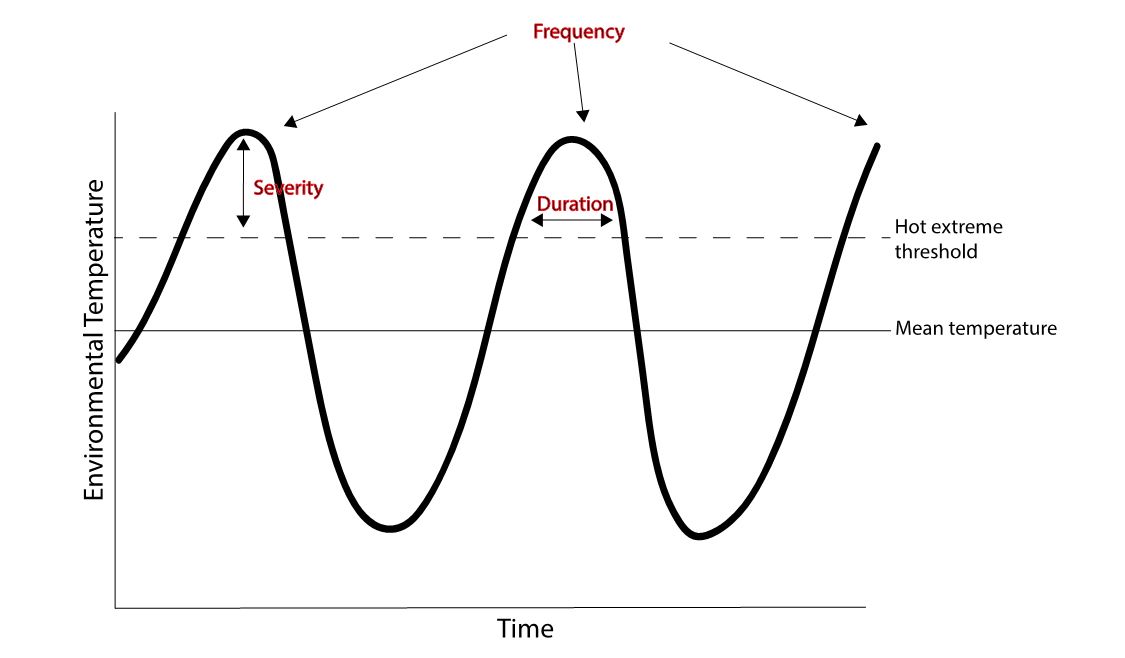The Science of Extremes
The Science of Extremes

Extreme is a word that can send a climate communicator directly into the swamp: the word extreme is inherently a bit alarming, and vague enough to warrant a multi-sentence qualification when you use it. Even scientists disagree on what this word means and in which context it is appropriate. The major issue with the word, “extreme”, is that it has too many uses, but little distinction between them. For the purpose of this explanation, I’ll speak in the context of global temperature as it relates to body temperature, since it is the most commonly discussed climate change topic. Keep in mind, these concepts related to the word extreme are fully applicable to other environmental factors like precipitation, salinity, dissolved oxygen, and ocean pH.
The first major distinction is between climatic and biological extremes.
-
Climatic extremes mostly deal with some sort of statistical departure from the average temperature – something that is not within the normal window of temperatures usually experienced in a specific context.
-
Biological extremes refer to individual experiences above a certain performance threshold, such as optimal swimming speed, defined at a specific temperature. Performance thresholds usually have to do with a body function that is essential for an animal to survive for long periods of time.

Fig. 1: Climatic vs. biological extremes. (graph by R. Tanner)
The second major consideration is timescale: geologic, climatic (30+ years), seasonal, and daily. Timescales, or the relative windows of history we are considering, provide context to the mean temperature being used to define “extreme”. Biological extremes are primarily relevant at the seasonal and daily timescales, since only evolutionary processes operate at higher order timescales (e.g. geologic).
-
Geologic (thousands-millions of years): Average conditions spanning all of humankind’s existence may not be as extreme when compared with previous ice ages and warm periods.
-
Climatic (decades): Since the industrial revolution, the climate has been both warming and increasing unpredictable fluctuations in temperature from year to year. An extreme event in the last 10 years has a much different definition – in both size and likelihood – than an extreme event experienced by our great-grandparents.
-
Seasonal (months): Winter and summer have very different definitions of extreme, so this can be a confusing wrench in the conversation if we only consider above a certain temperature to be extreme. If you live in the northern US and experience a day of 80°F, this would not necessarily be extreme in the summer, but it definitely would be in the winter.
-
Daily: Night and day have different average temperatures.
There is no better visualization of this than the “Pumphandle 2016” YouTube video. In this video, we see a continuous graph of temperature throughout geologic time, using multiple sources of data (ice cores, weather stations, etc.). The consistent up and down movement of the graph shows the effects of seasons (more pronounced at higher latitudes), but notice that the average concentration of CO2 on the Y axis on the left graph increases over time, across all latitudes. Pay attention to the major swings in daily and seasonal temperatures reflected in the modern record, and to the pattern in the ~1970s-present graph on the right to think about climatic timescales. Around the 2:20 minute mark, we can see pre-industrial and then ice age conditions, or “before significant human contributions to atmospheric CO2”, to grasp geologic timescales. Keep in mind when viewing the geologic timescale represented in the video that our ability to see daily, or even monthly fluctuations in historical climate is not as easy as current measurements, and therefore we miss many documentations of historical “extreme” temperatures.
The final, most nuanced, distinction is the flavor of extreme. Extremes are defined by three things: severity, frequency, and duration.
-
Severity: the magnitude of “extreme”, or how far over a specific threshold an event is.
-
Frequency: the number of events that exceed a specific threshold within a certain time period.
-
Duration: the amount of time spent at some temperature above a specified “extreme” threshold.

Fig. 2: Extreme, as defined by severity, frequency, and duration. (graph by R. Tanner)
Any combination of the above definitions is currently, by scientists, labeled an extreme. There may be a seasonal period characterized by multiple, short high-severity heat events (i.e. an intertidal zone in the summer) or a multi-year period characterized by one long departure from historical mean temperatures (i.e. the “Great Pacific Warm Blob of 2013-2015”). These would both be considered climatic extremes. Animals living in these environments have their own definitions of extreme, based on how they interact with the environment and what their body’s limits are (when do they stop eating, moving, reproducing). For example, a snail and a fish living in a tide pool exposed to frequent climatic extremes may experience biological extremes at very different magnitudes depending on their evolutionary histories. This is why it is important to be clear in our understanding of the differences between biological and climatic extremes. An increase in climatic extremes may be driving SOME organisms to reduce the frequency (Fig. 2) of their biological extremes under a future climate through adaptation (see Fig. 1, blue lines). It is not a linear relationship, and not all organisms in the same habitat experience climatic extremes the same way.
This is a very important point for those of us looking to inject some hope into the extreme climate change story. Extremes are context-specific, and therefore so must be our solutions. The variation in types of extremes is large, and our action to address it must be as well. These extreme events may be unpredictable from a short-term perspective, but we can make long-term adaptive community decisions even beyond climate change mitigation (the most frequently referenced NNOCCI solution) to address tangible effects of often-devastating extreme events.
Additional primary literature readings:
Dowd, W. W., King, F. A. & Denny, M. W. Thermal variation, thermal extremes and the physiological performance of individuals. Journal of Experimental Biology 218, 1956–1967 (2015).
Kharin, V. V. et al. Risks from Climate Extremes Change Differently from 1.5°C to 2.0°C Depending on Rarity. Earth’s Future 6, 704–715 (2018).
National Academies of Sciences, E., and Medicine. Attribution of extreme weather events in the context of climate change. (National Academies Press, 2016).
Williams, C. M. et al. Biological Impacts of Thermal Extremes: Mechanisms and Costs of Functional Responses Matter. Integrative and Comparative Biology 56, 73–84 (2016).
About the Author:
Dr. Richelle Tanner is a Postdoctoral Research Associate at Washington State University, specializing in marine evolutionary and environmental physiology, climate change effects, and bioinformatics. She also serves as chair of the Science Partnerships Committee of the National Network for Ocean and Climate Change Interpretation.
This article was originally posted July 10, 2019. Given recent events, it seemed wise to re-post.
More Blog Posts
 Climate Emotions: Helpless Or Hopeful?Climate Emotions: Helpless Or Hopeful? by Heidi Zamzow, April 17 2019 With the recent IPCC warning that we may have perhaps a dozen years before we encounter severe and irreversible impacts of climate change, it comes as little surprise that a recent survey* in climate communications research indicates 7 in 10 people in the U.S. are concerned [READ MORE]
Climate Emotions: Helpless Or Hopeful?Climate Emotions: Helpless Or Hopeful? by Heidi Zamzow, April 17 2019 With the recent IPCC warning that we may have perhaps a dozen years before we encounter severe and irreversible impacts of climate change, it comes as little surprise that a recent survey* in climate communications research indicates 7 in 10 people in the U.S. are concerned [READ MORE] My Community is My Hope #100HopefulDaysMy Community is My Hope #100HopefulDays Sarah-Mae Nelson, MS, CIG/CIT, February 03 2017 Today I turn 37 years old. This seems like an impossible number. In my mind, I am a vibrant 21-year-old eager to make the world a better place. I see opportunities to make a positive difference everywhere. I am young, I am empowered, and I am unstoppable. In [READ MORE]
My Community is My Hope #100HopefulDaysMy Community is My Hope #100HopefulDays Sarah-Mae Nelson, MS, CIG/CIT, February 03 2017 Today I turn 37 years old. This seems like an impossible number. In my mind, I am a vibrant 21-year-old eager to make the world a better place. I see opportunities to make a positive difference everywhere. I am young, I am empowered, and I am unstoppable. In [READ MORE] Rosemary Mosco: Climate IllustrationRosemary Mosco: Climate Illustration by Allison Arteaga, March 18 2019 A comic that circulated through social media this past month spread hope on climate change to thousands, and it was all inspired by the artist’s connections to the National Network for Ocean & Climate Change Interpretation (NNOCCI). “Climate Worries”, a cartoon by science [READ MORE]
Rosemary Mosco: Climate IllustrationRosemary Mosco: Climate Illustration by Allison Arteaga, March 18 2019 A comic that circulated through social media this past month spread hope on climate change to thousands, and it was all inspired by the artist’s connections to the National Network for Ocean & Climate Change Interpretation (NNOCCI). “Climate Worries”, a cartoon by science [READ MORE] To Frame Climate Change, Lead with a Researched Value—Not a “Rogue” OneTo Frame Climate Change, Lead with a Researched Value—Not a “Rogue” One January 20 2017 This is the sixth post in a series about framing ocean and climate change. So, you want to motivate the public to take action to address climate and ocean change? One of the most important communications moves you can make is to open with a broad statement [READ MORE]
To Frame Climate Change, Lead with a Researched Value—Not a “Rogue” OneTo Frame Climate Change, Lead with a Researched Value—Not a “Rogue” One January 20 2017 This is the sixth post in a series about framing ocean and climate change. So, you want to motivate the public to take action to address climate and ocean change? One of the most important communications moves you can make is to open with a broad statement [READ MORE] “Ask a Scientist”“Ask a Scientist” by Richelle Tanner, March 26 2020 We had a great turnout for our “Ask a Scientist” interactive break-out session at the latest NNOCCI Virtual Conference, but there were so many questions that we didn’t get to! For those of you who couldn’t join us, we’re also summarizing the conversations that participants had with our [READ MORE]
“Ask a Scientist”“Ask a Scientist” by Richelle Tanner, March 26 2020 We had a great turnout for our “Ask a Scientist” interactive break-out session at the latest NNOCCI Virtual Conference, but there were so many questions that we didn’t get to! For those of you who couldn’t join us, we’re also summarizing the conversations that participants had with our [READ MORE]